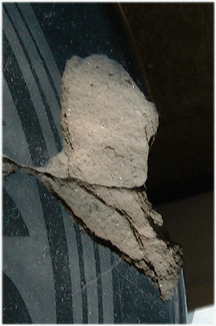Maria Martinez pottery repair is very difficult but possible with attention to the fine surfaces and paint layers that were applied. The ceramic is designed after centuries of traditional pottery craftsmanship the use of traditional materials. Maria frequently endowed the new pottery she was building from coils with "the old," by integrating the clay body with ground pottery shard temper that she had collected. Maria would walk through the areas around San Illdefonso looking for fragments of old ceramics that she liked. With an eye for designs and style she selected attractive shards to use in the clay body of her new creations. She would also gift some the nicer shards to friends, who have reported this practice to me...
Pottery
To look at Maria's work as pots or simply pottery is to miss the investment
that tradition, intuition, and years of proficiency, lots of practice,
and perfecting her craft that went into the fine ceramics that bare her
name. There is an implicit quality, a kind of spiritual presence that
transcends the physical object when you study her work and her life. Her
friends like Francis Harlow and Susan
Peterson have written and spoke (Link to Interview) of her with the
utmost respect. These publications are an enrichment and education when
associated with appreciation of the ceramic art. See "The
Living Tradition of Maria Martinez"
by Susan Peterson,
and
"Historic
Pueblo Indian Pottery" by Francis Harlow.

Ouch!
The detail that is necessary for repair and restoration is secondary to the conservation of these fine ceramics and artifacts of a past era. Working on these ceramics is done well when done with respect. They are not just an investment financially, but represent the finer aspects of San Illdefonso Pueblo material culture. With this in mind a lot of time is needed to asses the individual issues that the "time traveler" or ceramic has experienced and determine the processes that have influenced the condition it is in now and was originally. Understanding this process is very helpful to finding the previous attempts to "enhance" the original work with the all to frequently applied layers of shoe polish. Yes, shoe polish was used to make the shinny black ceramic more shinny or sale-able and cover up scratches or rubbed areas.
Because of this practice it is very necessary to start by removing any surface coatings and find previous damage or repairs. This frequently reveals clues to the history of the ceramic since it was made. We can stabilize abrasions to the surface with water based material and determine the extent of repair and restoration necessary, possible, or desirable. Chips, cracks, and other breakage can only be addressed after the full extent of damage has been observed and foreign materials removed that could and probably would impede adhesion of repair or restoration materials.
When completed the goal is the same as when the project was started, to conserve and protect the original work of Maria Martinez.